Menus
- Greedy for revs and fascinating
- Below-nothing-and-above-everything characteristic
- Future of the 600 super sports car
- Moto2 engines from the Honda CBR 600 RR
- Technical data R6

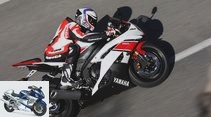
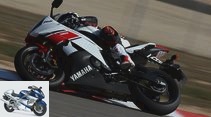
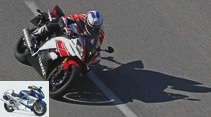
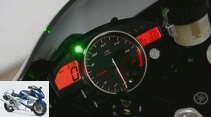
11 photos
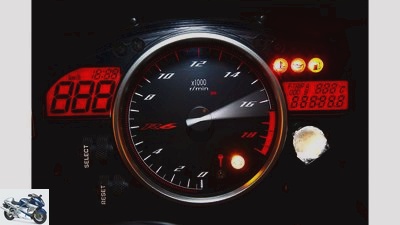
Bilski
1/11
Such speeds are only useful for 600 series racing motorcycles. But they also go off the rails easily for series machines.
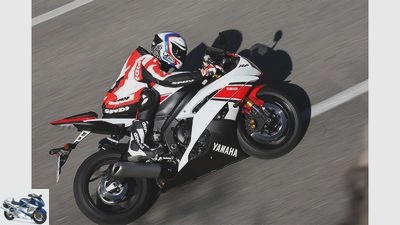
2/11
Yamaha YZF-R6.
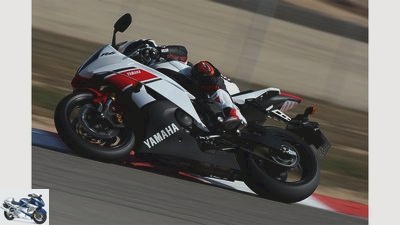
3/11
Yamaha YZF-R6.
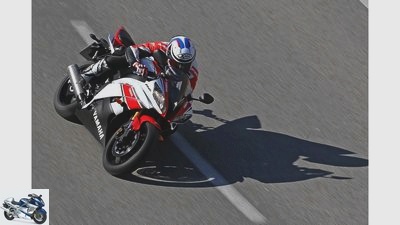
4/11
Yamaha YZF-R6.
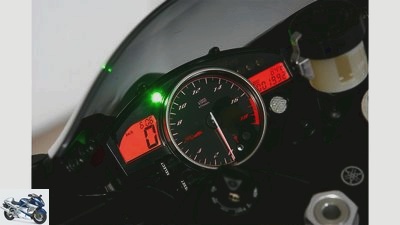
5/11
The wheelbase is 1380 mm, the steering head angle 66 degrees, the caster 97 mm. With a weight of 192 kg with a full tank, the R6 manages a top speed of 270 km / h. The acceleration from 0 to 100 km / h is done in 3.5 seconds.
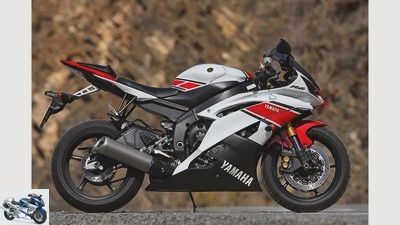
6/11
At a price of 12,595 euros, the PS costs the equivalent of around 100 euros. But you also get a light metal bridge frame, an upside-down fork, double disc brake at the front (Ø 310 mm) and disc brake (Ø 220 mm) at the rear.
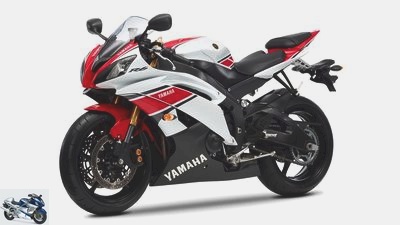
Yamaha
7/11
On the torque side, it pushes 66 Nm at 11,000 rpm.
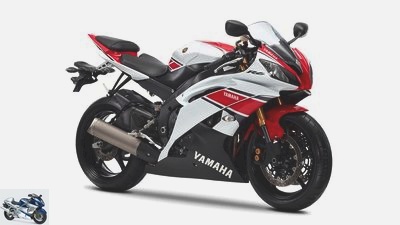
Yamaha
8/11
Its four-cylinder in-line engine with 599 cm³ produces 95 kW (129 hp) at 14,500 rpm.
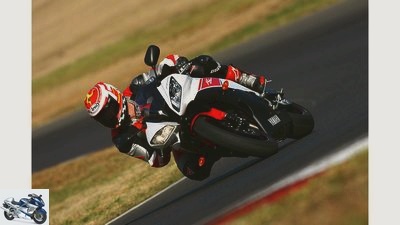
Yamaha
9/11
Representing the others, the R6 impresses with its agility, precision and cornering stability.
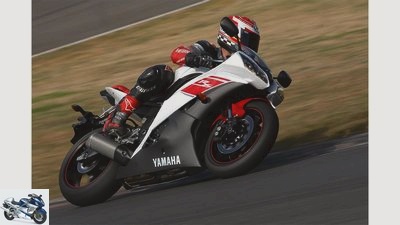
Yamaha
10/11
600s have a liter output of over 200 hp and are noticeably lighter than the large 1000 cubic bikes.
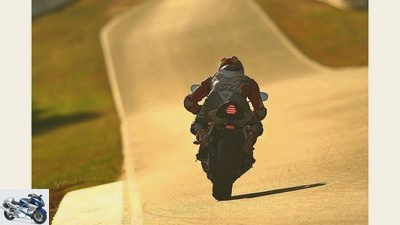
Yamaha
11/11
May this atmospheric photo not become symbolic and the dusk for the 600s will not come for a long time.
Impression Yamaha YZF-R6
Greedy for revs and fascinating
Anyone can do it with more displacement. Getting a lot of power out of small engines is the real art, and in no other type of motorcycle does it reach such a high level as with the 600 super sports bikes. Extremely speed-greedy, they are not easy to drive, but fascinating.
The first traffic light already reveals it. Out of habit, I put on a commode 1000 rpm to start up and engage the clutch. Maaaooooh. Oops, quickly increase the speed, let the clutch grip again. The powerful four-cylinder of the Yamaha YZF-R6 still sounds like a depressive ghost and sinks into the next torque hole.
Buy complete article
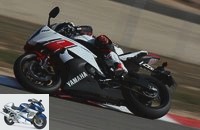
Impression Yamaha YZF-R6
Greedy for revs and fascinating
YZF-R6 finally swinging off the line. Instead, a group of pedestrians are shaking their heads blankly. And I think I can see how the driver behind me taps his forehead at the next red light. He should. Because it is the last traffic light away from Stuttgart, he gets it served in five digits for the next green phase. At least the Yamaha and I are happy.
Below-nothing-and-above-everything characteristic
Admittedly, the Yamaha YZF-R6 could also be started at a lower speed, but that is not that easy with the energetic clutch. Anyone who has learned the necessary ruthlessness in dealing with speeds and the necessary sensitivity when adjusting the clutch on sophisticated two-stroke engines will consider the R6’s weak starting torque to be a luxury problem. But very few are. The majority of motorcyclists, younger and older, do not start much with this below-nothing-and-above-everything characteristic of the “small” high-performance engines.
For a better understanding: The 600 series have been doing for a long time what the 1000 series super sports cars have only recently achieved: liter outputs of around 200 hp. Because they need higher speeds than the 1000 series with less displacement, the torque values are lower. The gas exchange of the 600 series has been optimized for the highest speeds and is therefore rather sluggish in the lower range. The Yamaha YZF-R6 tries to address this problem with variable velocity stacks – long for the bottom, short for the top. Their success consists in the fact that one would rather not know what it would be like without them. And last but not least, the performance of the 600 series suffers from the fact that it has not been further developed for years. Kawasaki is the notable exception.
Future of the 600 super sports car
The reason for the reluctance of the manufacturers lies in the collapse of the strongest 600 markets in Europe, Italy and Spain in the wake of the financial crisis. Young people, the largest group of potential buyers, have since suffered the most from unemployment, and as inexpensive everyday vehicles, motorcycles like the Yamaha YZF-R6 are too expensive to buy and maintain. Your favorite speeds can only rarely be achieved in public transport. The only habitat that is at least appropriate to the character of the engine is the German autobahn apart from the racetrack. As you can see, these fascinatingly pointed motorcycles are an endangered species that is under pressure from many sides. In all likelihood, the conventionally braked Yamaha YZF-R6 and Suzuki GSX-R 600 will come to an end when the ABS obligation for new motorcycles comes into force in 2017, because the incentive to equip these motorcycles with ABS is low. Honda no longer offers the CBR 600 RR, which has had ABS since 2009, in Germany. Hopefully Suzuki and Yamaha will think differently than feared, and Kawasaki will stay on the ball with the ZX-6R.
There are also good reasons for the 600s to continue. The incomparable driving experience, for example. Their chassis have the rigidity, their spring elements the responsiveness and damping reserves of real sports machines, and they are even lighter than the 1000s. And since these tire dimensions have existed, the interaction of a 120/70 front tire with a 180/55 rear, standard in the 600 class, has seemed the ideal to me. Wonderful handiness and good grip – it took a long time before the 190s and 200s with high cross-sections of 55 or 60 percent of the width came close. Which doesn’t mean they achieved it. The Yamaha YZF-R6 shows me the difference that is still there as soon as it’s on the winding road. Regardless of whether it is a country road or a race track, it pampers you with a combination of agility, precision and cornering stability that you don’t often come across. A long curve, full lean, the driver hangs inside next to the motorcycle, pulls the engine with relish and still maintains the tight line – there is hardly a machine that supports its driver better in such maneuvers. And if so, then it comes from the group of the other 600 or 675 three-cylinder.
Moto2 engines from the Honda CBR 600 RR
This is how motorcycles are designed with which, as a racing novice, you can learn precise driving and high speeds when entering bends. And as an old hand sharpened his line again. A fat torque is just in the way. It is not without reason that the standard engine of the Moto2 class in Grand Prix racing comes from the Honda CBR 600 RR. In contrast to the series engines, only the cylinder heads are machined with CNC machines and the running clearances of pistons, connecting rod and crankshaft bearings are brought to a uniform level in order to create equal opportunities for all drivers. Highly tuned engines from the Supersport World Cup are more powerful and pointed than the Moto2 engines. Eight years ago I had the opportunity to ride several motorcycles from the Supersport World Championship, including a Yamaha YZF-R6 from the Lorenzini team, with which Massimo Roccoli hunted for World Championship points. To my greatest surprise, it didn’t spin any higher than the production bike, instead it struck at the same revs with a truly explosive temperament. What an experience! However, a high price has to be paid for this in the form of increased maintenance costs. After a few hundred kilometers, at least the crankshaft and connecting rod bearings have to be replaced, along with the timing chain and tensioner, and possibly the valves. All series parts, as prescribed by the regulations. So they don’t cost the world, but working hours do. But you don’t have to exhaust the engines to this point or put them in special GP chassis to get an attractive junior class.
It hurts to think that the motorcycles with such potential could disappear. Perhaps the manufacturers should invest again, make their performance a little more suitable for everyday use and their noise development more socially acceptable. So that there will also be motorcycles in the future for those very special turning moments.
Technical data R6
Yamaha
129 hp from 599 cc. You only get that at 14,500 rpm.
Related articles
-
BMW R 1200 R and Yamaha YZF-R6 same performance class
24 photos 1/24 BMW R 1200 R and Yamaha YZF-R6 in the test. 2/24 BMW R 1200 R and Yamaha YZF-R6 in the test….
-
Yamaha YZF-R6 in the PS driving report
Yamaha 17 pictures Yamaha 1/17 Yamaha YZF-R6 in the driving report. Yamaha 2/17 Optically, the new R6 was based heavily on the Superbike YZF-R1. Characteristic …
-
Short test: 2010 Yamaha YZF-R6 The new Yamaha YZF-R6 being tested So far it was clear: no other 600 series was so radical, so loud, so…
-
Comparison test between Kawasaki ZX-6R and Kawasaki ZX-9R, Yamaha YZF-R6 and Yamaha R1
Artistic comparison test Kawasaki ZX-6R against Kawasaki ZX-9R Yamaha YZF-R6 against Yamaha R1 Attack from the depth Technically unchanged go Kawasaki ZX-9R …
-
Manix Impression Yamaha XJ 900 N As before An encounter with the ex: editor Thomas Schmieder had the opportunity to once again drive the exact same…
-
Impression: Yamaha HL 500 Time Machine MOTORRAD editor Gert Thole, 46, dared a journey into his own past: almost 25 years after his racing debut, he…
-
Yamaha YZF-R6 (2017) in the driving report
Yamaha 30 pictures 1/30 The new Yamaha YZF-R6 in the driving report. 2/30 The new Yamaha YZF-R6 in the driving report. 3/30 The new Yamaha YZF-R6 in the driving report. 4/30 …
-
single test: Yamaha YZF-R6 The revised Yamaha YZF-R6 content of The R6 has its radically race-like appearance by and large …
-
Driving report factory Yamaha YZF-R6
Edge Driving report factory Yamaha YZF-R6 Supersport R6 The fact that Yamaha again failed to wrest the Supersport World Championship title from Honda in…
-
On the move: the Honda VF 500 F II and Yamaha RD 500 LC
fact On the move: Honda VF 500 F II and Yamaha RD 500 LC Extreme athlete Content of At the beginning of 1984, the Honda VF 500 F II and Yamaha RD 500 LC…